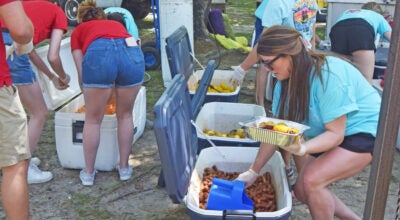Bivens’ column: Be smart, safe in the kitchen
Published 8:03 am Wednesday, February 18, 2015
Have you ever run across an article the makes you say…”Umm, really? I didn’t realize that?”
I found the following article very interesting and thought provoking. Written by my colleague Amelia Mitchell, food safety and food preservation REA, and titled “Kitchen Food Safety: Bags, Bottles & Beyond,” I thought I would share it:
When we think kitchen food safety, the following six unsafe practices may not come to mind. They should. Do you avoid them? Please do.
Using non-food grade materials
Just because a material looks like a suitable food container doesn’t make it safe for food. Four common nonfood grade items we should avoid using include the following.
Do not use brown paper bags from grocery or other stores for cooking. They are not sanitary, may cause a fire, and can emit toxic fumes. Intense heat may cause a bag to ignite, causing a fire in the oven…The ink, glue, and recycled materials in paper bags can emit toxic fumes when they are exposed to heat. Instead, use purchased oven cooking bags.
Don’t use film canisters for food storage. If a product isn’t sold to hold food, don’t use it for this purpose. A commonly used nonfood item is film canisters. Use small food storage containers instead.
Plastic trash bags for food storage. The use of plastic trash bags for food storage or cooking is not recommended by USDA “… because they are not food grade plastic and chemicals from them may leach into the food.”
Reusing one-time-use items
While some items should not be used with foods, others should be used only ONCE, and then for their intended purpose. For example, USDA states: “Plastic wrap, foam meat trays, convenience food dishes, and egg cartons have been approved for a specific use and should be considered one-time-use packaging. Bacteria from foods that these packages once contained may remain on the packaging and thus be able to contaminate foods or even hands if reused.”
Misusing materials in the microwave
Microwave your food in safe ways using safe containers. USDA advises to microwave food in packaging materials only if the package directs, and then use only one time. Materials suitable for microwaving include oven bags, wax paper and plastic wrap. Do not let the plastic wrap touch the food, and do not reuse the wrap.
Foam insulated trays and plastic wraps on fresh meats in grocery stores are not intended by the manufacturer to be heated and may melt when in contact with hot foods, allowing chemical migration into the food. In addition, chemical migration from packaging material to a food does not necessarily require direct contact. Excessive heat applied to a closed container may discharge off chemical gases from the container that can contaminate the enclosed food.
These types of plastic products should not be used in a microwave oven because they are subjected to heat when thawing or reheating. To avoid a chemical migration problem, remove meats from their packaging.
Covering food helps protect against contamination, keeps moisture in, and allows food to cook evenly. Never use plastic storage bags, grocery bags, newspapers, or aluminum foil in the microwave.”
Misusing hard-to-clean items
Today, many families are busy rushing and running. Utensils that once were cleaned thoroughly after each use may get set aside. Cleaning is neglected or delayed. Consider these items:
• Whisks: When purchasing a metal whisk, some of the easiest ones to clean are stainless steel whisks with their wires attached to the handle with a watertight seal. They don’t rust, and food particles don’t get trapped in the handle.
• Sponges: Sponges are also hard to keep clean for use on food contact surfaces, such as dishes and countertops. Sponges provide an ideal location for bacteria to grow. Bacteria thrive in the warmth, moisture and food collected on sponges.
Sponges should be cleaned and dried after each use and changed frequently. While the recommendation is sometimes made to heat wet sponges in the microwave, the guidelines are not precise and there is a possibility of fire.
• Dishcloths: Dishcloths are easier to keep clean than sponges and can be purchased very inexpensively. A clean one can be used every time a person does the dishes or wipes the counter. Launder dishcloths in the washing machine in hot water and dry in a hot dryer. Or, use paper towels. A third possibility is to use a combination of paper towels and dishcloths. Some people find it easier to wipe up small spills and clean small areas with a paper towel and to use a dishcloth for cleaning larger areas.
Re-using items that should be laundered
Dishcloths and dishtowels should be washed after use. Wet or damp dishtowels and cloths are ideal environments for bacterial growth. Allow them to air dry before tossing them into a laundry basket. Have a good supply so it is not necessary to re-use them before laundry day.





